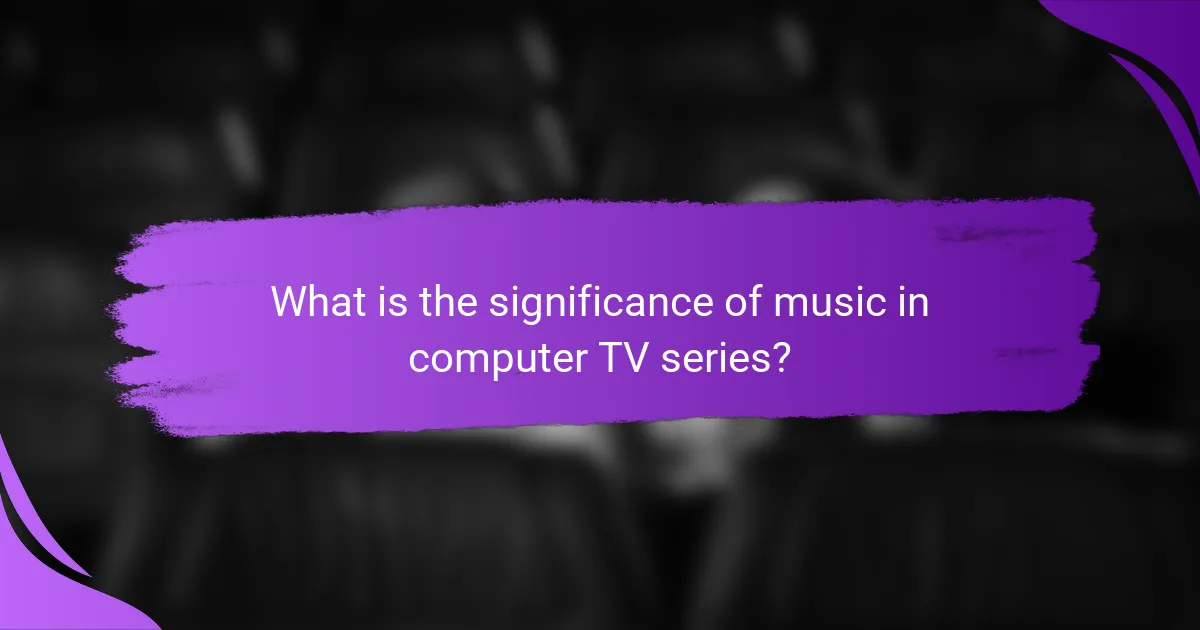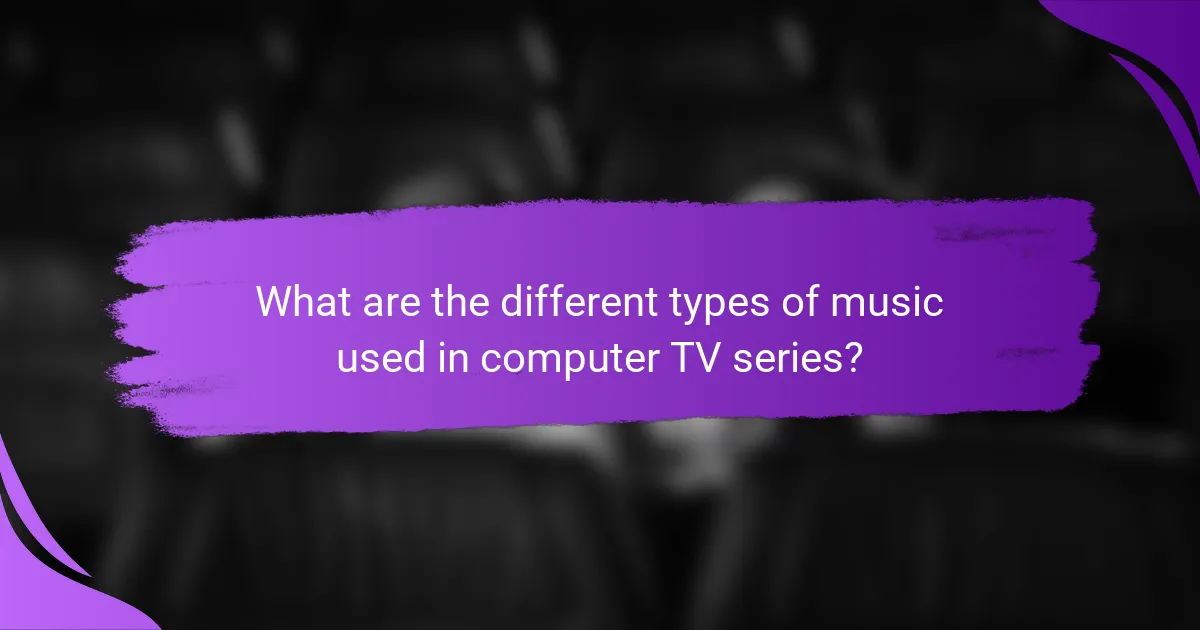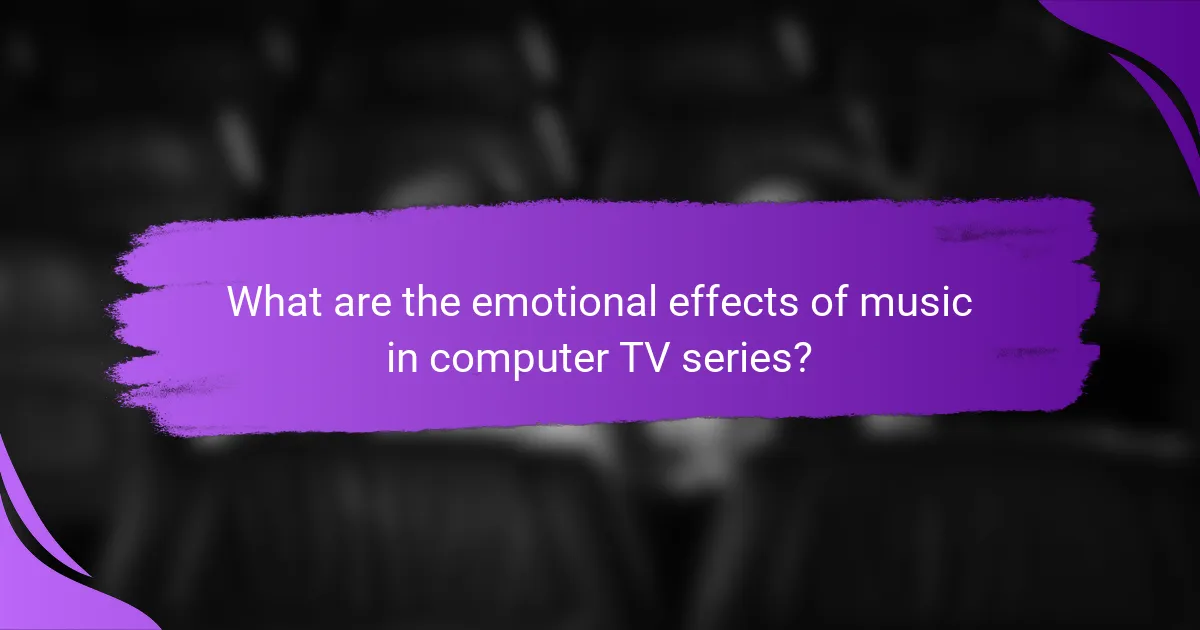Music plays a crucial role in computer TV series, significantly enhancing storytelling and influencing audience emotions. Various types of music, including orchestral scores, electronic music, and licensed tracks, contribute uniquely to the viewing experience by setting the tone and mood for scenes. Research indicates that music can evoke specific emotional responses, deepen viewer connections to characters, and improve memory retention of key moments. Notable examples, such as the use of synth and orchestral elements in “Stranger Things,” illustrate how diverse musical landscapes enrich narratives and engage viewers effectively. Overall, the significance of music in computer TV series lies in its ability to create emotional depth and enhance audience engagement.

What is the significance of music in computer TV series?
Music in computer TV series plays a crucial role in enhancing storytelling. It sets the tone and mood for scenes, influencing audience emotions. For instance, a suspenseful score can heighten tension during critical moments. Conversely, uplifting music can evoke feelings of joy and triumph. The use of motifs associated with characters deepens viewer connection. Iconic themes become recognizable, leaving a lasting impression. Research shows that music can enhance memory retention of scenes. Overall, music significantly enriches the viewing experience in computer TV series.
How does music enhance storytelling in computer TV series?
Music enhances storytelling in computer TV series by creating emotional depth and guiding audience engagement. It sets the tone and atmosphere, influencing how viewers perceive characters and events. For instance, a suspenseful score can heighten tension during critical moments. Conversely, uplifting music can evoke feelings of joy or triumph. Research shows that music activates emotional responses in viewers, making scenes more memorable. Specific soundtracks can also become iconic, associating particular themes with characters or narratives. Overall, music serves as a powerful narrative tool that enriches the viewing experience.
What role do soundtracks play in character development?
Soundtracks play a crucial role in character development by enhancing emotional depth and narrative context. They help to convey a character’s internal struggles and motivations. For instance, a character’s theme can reflect their personality traits or emotional state. This use of music creates a stronger connection between the audience and the character. Research shows that soundtracks can influence viewers’ perceptions of characters, shaping their understanding and empathy. In shows like “Stranger Things,” specific songs are tied to character arcs, reinforcing themes and emotional moments. Therefore, soundtracks are integral to character development in visual storytelling.
How does music influence plot progression in episodes?
Music influences plot progression in episodes by enhancing emotional engagement and guiding narrative flow. It sets the tone for scenes, creating anticipation or tension. For example, a suspenseful score can heighten the stakes during climactic moments. Additionally, music can signify character development or thematic shifts. Iconic themes often signal key plot points or character arcs. Research indicates that music affects viewer perception and memory, making pivotal scenes more memorable. Studies show that well-timed music can increase viewer satisfaction and emotional response. Therefore, music is a crucial element in shaping how audiences experience and interpret plot developments.
Why are soundtracks crucial to the viewer’s experience?
Soundtracks are crucial to the viewer’s experience because they enhance emotional engagement and narrative depth. Music influences the audience’s feelings and reactions to scenes. For instance, a suspenseful score can heighten tension during critical moments. Conversely, a serene melody can evoke feelings of peace or nostalgia. Research shows that soundtracks can significantly affect memory retention of scenes. A study published in the Journal of Experimental Psychology found that music can enhance emotional responses, making scenes more memorable. Thus, soundtracks play a vital role in shaping how viewers connect with the story and characters.
How do soundtracks evoke emotions in the audience?
Soundtracks evoke emotions in the audience by utilizing musical elements that trigger psychological responses. Composers use melody, harmony, and rhythm to create specific moods. For example, minor keys often evoke sadness, while major keys can inspire happiness. Tempo also plays a crucial role; faster tempos can create excitement, while slower tempos can induce calmness.
The use of dynamics, such as volume changes, can heighten emotional impact. Sudden loud sounds may create shock or surprise, while soft passages can evoke intimacy or reflection. Instrumentation adds another layer; strings often convey warmth, while brass can evoke power.
Research shows that music can influence mood and memory. A study published in the Journal of Experimental Psychology found that music significantly affects emotional recall. This shows a direct link between soundtracks and emotional engagement in media.
What impact do iconic themes have on audience recall?
Iconic themes significantly enhance audience recall. These memorable musical motifs create strong associations with specific characters or moments. Research indicates that music activates emotional memories, making content more relatable. A study by Janata et al. (2007) shows that familiar tunes can trigger vivid recollections of past experiences. Iconic themes often serve as auditory cues, prompting immediate recognition and emotional responses. This connection helps audiences remember plot points and character arcs more effectively. Overall, iconic themes play a crucial role in reinforcing memory retention in television series.

What are the different types of music used in computer TV series?
Computer TV series utilize various types of music, including orchestral scores, electronic music, and licensed tracks. Orchestral scores provide dramatic depth and enhance emotional moments. Electronic music often reflects technological themes and futuristic settings. Licensed tracks feature popular songs that resonate with the audience and set the tone for specific scenes. Each type of music contributes uniquely to the storytelling and viewer engagement. For instance, shows like “Stranger Things” use a mix of synth and orchestral elements to evoke nostalgia and tension. This diverse musical landscape enriches the overall viewing experience.
How do original scores differ from licensed music?
Original scores are composed specifically for a particular film, show, or project. They are tailored to fit the narrative and emotional context of the visual content. Licensed music, on the other hand, consists of pre-existing songs that are acquired for use in a project. This music is not originally created for the specific context but is selected for its existing popularity or emotional resonance.
Original scores often feature unique compositions that enhance storytelling. They can include motifs that evolve throughout the project. Licensed music may evoke familiarity and nostalgia but lacks the tailored emotional depth of an original score.
In many cases, original scores are created by composers who work closely with directors. This collaboration ensures that the music aligns with the intended atmosphere. Licensed music is typically chosen from a library of existing tracks, which may not always match the specific themes of the project.
The impact of original scores can be profound, as they are crafted to resonate with specific scenes. This can lead to more immersive viewer experiences. Conversely, licensed music can sometimes distract from the narrative if it is too recognizable or popular.
What are the benefits of using original compositions?
Original compositions enhance emotional engagement in TV series. They provide a unique auditory identity for the show. This distinctiveness helps viewers connect more deeply with characters and storylines. Original music can evoke specific feelings tailored to scenes, creating a more immersive experience. Studies show that original scores significantly increase viewer retention and satisfaction. For instance, a study by the University of Southern California found that original music enhances memory recall of scenes. Additionally, original compositions support narrative themes, reinforcing the overall message of the series. They also allow for creative freedom, enabling composers to craft music that perfectly aligns with the show’s vision.
How does licensed music contribute to authenticity?
Licensed music enhances authenticity by providing a genuine auditory experience that aligns with the narrative context. It connects the viewer to the time period or culture depicted in the show. For example, using popular songs from a specific era can evoke nostalgia and emotional resonance. This connection helps to create a more immersive viewing experience. Furthermore, licensed music often carries cultural significance, which adds depth to character development and storytelling. Studies have shown that audiences respond positively to familiar music, increasing their emotional engagement. Therefore, licensed music is crucial in establishing a believable and relatable atmosphere in TV series.
What genres of music are commonly featured in computer TV series?
Computer TV series commonly feature genres such as electronic, synth-pop, and ambient music. These genres align with the technological themes often present in such series. Electronic music enhances the futuristic and digital atmosphere of the narratives. Synth-pop adds an upbeat and nostalgic tone, often reflecting the 1980s and 1990s tech culture. Ambient music provides a backdrop that emphasizes tension and emotion. Series like “Black Mirror” and “Mr. Robot” exemplify the effective use of these genres to enhance storytelling. The choice of music plays a crucial role in shaping viewers’ emotional responses and engagement with the content.
How do electronic and orchestral styles shape the narrative tone?
Electronic and orchestral styles shape the narrative tone by creating distinct emotional landscapes. Electronic music often introduces a modern, futuristic, or even dystopian feel. It can evoke tension, urgency, or excitement through synthesized sounds and rhythms. In contrast, orchestral music typically conveys a sense of grandeur, emotion, or nostalgia. It uses a wide range of instruments to create rich textures and harmonies. The combination of these styles allows for a dynamic storytelling approach. For example, in sci-fi series, electronic elements may underscore technological themes, while orchestral scores can enhance character-driven moments. This interplay influences viewer perception and engagement with the narrative.
What are the trends in music selection for different series genres?
Trends in music selection for different series genres include the use of genre-specific soundtracks, emotional resonance, and nostalgia. Various genres leverage music to enhance storytelling. For example, dramas often use orchestral scores to evoke deep emotions. Comedies frequently incorporate upbeat and lighthearted tracks to maintain a cheerful tone.
In horror series, unsettling soundscapes and dissonant chords create tension and fear. Sci-fi shows often feature electronic music to complement futuristic themes. Additionally, the integration of popular songs can attract viewers through nostalgia. Recent studies show that music choice significantly impacts audience engagement and emotional response.

What are the emotional effects of music in computer TV series?
Music in computer TV series significantly influences viewers’ emotions. It enhances storytelling by evoking feelings such as joy, sadness, or tension. For instance, a suspenseful score can heighten anxiety during critical moments. Conversely, a melodic theme can create a sense of nostalgia or warmth. Research indicates that music triggers emotional responses by activating brain areas associated with memory and emotion. A study published in the Journal of Media Psychology found that specific musical cues can increase audience engagement and emotional investment in characters. This demonstrates that music is essential for creating emotional depth in computer TV series.
How does music create tension and suspense?
Music creates tension and suspense through specific elements such as dissonance, dynamics, and tempo. Dissonant chords create an unsettling feeling, signaling potential danger. Sudden changes in dynamics can startle the audience, heightening emotional responses. A fast tempo can increase anxiety, making viewers feel urgency. Conversely, a slow tempo can build anticipation, prolonging suspense. The use of silence or pauses can also amplify tension by creating uncertainty. These techniques are commonly employed in film and television soundtracks to evoke strong emotional reactions. For example, the score of “Jaws” by John Williams effectively uses a simple two-note motif to create dread and anticipation.
What techniques do composers use to build suspense through music?
Composers build suspense through techniques such as dissonance, dynamics, and tempo changes. Dissonance creates tension by introducing clashing notes. This can evoke feelings of unease and anticipation. Dynamics involve varying volume levels to heighten emotional impact. Sudden changes in loudness can startle the audience, enhancing suspense. Tempo changes can accelerate the pace, creating urgency. Slower tempos can also be used to build anticipation. Additionally, the use of silence or pauses can amplify tension. These techniques collectively contribute to a gripping musical experience that enhances suspense in visual media.
How does silence or minimal music influence emotional impact?
Silence or minimal music enhances emotional impact by creating space for reflection and intensity. This absence of sound allows viewers to process emotions deeply. Research shows that silence can evoke feelings of tension and anticipation. Minimal music, on the other hand, can underscore pivotal moments without overwhelming the audience. A study by Brattico et al. (2016) found that sparse musical elements can heighten emotional responses in viewers. The strategic use of silence or minimalism in soundtracks amplifies the narrative experience. This technique is often employed in computer TV series to elevate dramatic scenes. Overall, silence and minimal music serve as powerful tools in shaping emotional resonance.
How can music foster viewer attachment to characters?
Music can foster viewer attachment to characters by enhancing emotional engagement. Specific musical themes can evoke feelings associated with characters. For example, a character’s unique melody can signal their presence and personality traits. This technique helps viewers associate specific emotions with the character. Research shows that music influences memory and emotional responses. A study by Juslin and Västfjäll (2008) confirms that music can elicit strong emotional reactions. Thus, when viewers hear a character’s theme, it can trigger fond memories and feelings. This connection deepens the viewer’s attachment and investment in the character’s journey.
What role does a character’s theme play in audience connection?
A character’s theme plays a crucial role in audience connection by evoking emotions and establishing identity. Themes create musical motifs that represent characters’ personalities and journeys. These motifs help viewers associate specific emotions with characters. For example, a heroic theme can elicit feelings of hope and courage. Research shows that music enhances emotional engagement in storytelling. A study by Brattico et al. (2017) found that thematic music influences viewers’ emotional responses. This connection deepens the audience’s investment in the characters’ arcs. Ultimately, character themes foster a more immersive viewing experience.
How does music signify character arcs and transformations?
Music signifies character arcs and transformations by reflecting emotional shifts and narrative progressions. Composers use specific motifs to represent characters, evolving these motifs as characters change. For instance, a character’s theme may start with a minor key, indicating struggle. As the character grows, the theme can shift to a major key, symbolizing triumph.
In television, this technique enhances storytelling by providing an auditory cue for viewers. Research shows that music can influence audience perception of character development. A study by Bruner (1990) highlights that music enhances emotional engagement, making character transformations more impactful.
Thus, music serves as a powerful tool in signifying character arcs and transformations. It deepens the connection between viewers and characters, enriching the overall narrative experience.
What are best practices for integrating music in computer TV series?
Best practices for integrating music in computer TV series include selecting music that enhances the narrative. Music should align with the emotional tone of scenes. It is essential to use motifs that reflect character development. Incorporating diegetic and non-diegetic music can create depth. Timing is crucial; music should complement key moments without overshadowing dialogue. Collaborating with composers ensures original scores fit the series’ style. Testing audience reactions to music choices can guide future decisions. Historical examples show that effective music integration improves viewer engagement and retention.
How can creators effectively choose music that aligns with themes?
Creators can effectively choose music that aligns with themes by identifying the emotional tone of their content. They should analyze the mood they want to convey, such as joy, tension, or nostalgia. Next, they can select music genres that reflect these emotions, like upbeat pop for happiness or orchestral scores for drama.
Using music libraries and platforms that categorize tracks by mood can streamline this process. Additionally, testing different tracks with the visuals can help determine which music enhances the intended theme. Studies show that music significantly influences audience perception and emotional response, reinforcing the importance of this alignment.
What tips can enhance the emotional resonance of soundtracks?
To enhance the emotional resonance of soundtracks, composers should focus on thematic consistency. Consistent themes create familiarity and emotional connection. Utilizing dynamics effectively can also amplify emotional impact. For example, crescendos can build tension, while softer passages evoke intimacy. Incorporating varied instrumentation adds depth to the emotional landscape. Strings often convey sadness, while brass can evoke triumph. Timing and pacing are crucial; well-timed musical cues align with emotional peaks in the narrative. Research shows that music synchronized with visual elements increases emotional engagement. A study by the University of Southern California found that soundtracks significantly impact viewer’s emotional responses to scenes.
The primary entity of the article is music in computer TV series, which plays a vital role in enhancing storytelling and emotional engagement. The article explores how music influences plot progression, character development, and audience connection through soundtracks and themes. It details the emotional effects of various music types, including original compositions and licensed tracks, and discusses techniques composers use to create tension and evoke emotions. Additionally, it highlights best practices for integrating music effectively to align with narrative themes, ultimately emphasizing music’s significance in enriching the viewing experience.